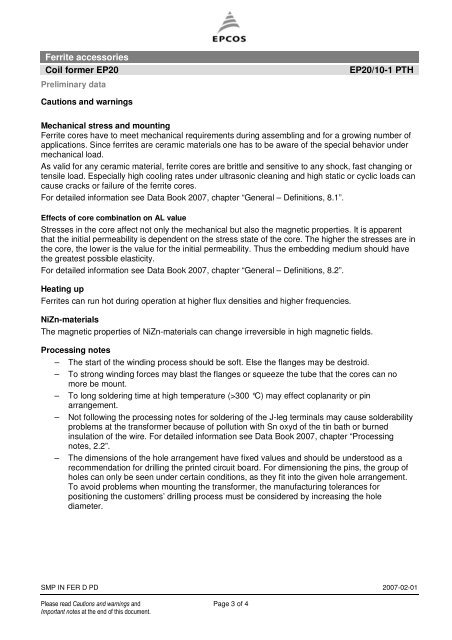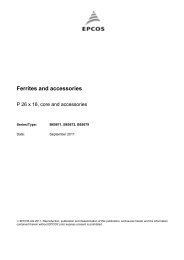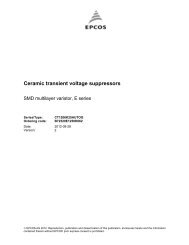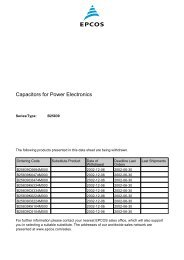Ferrites and accessories, EP20, Coil former - Epcos
Ferrites and accessories, EP20, Coil former - Epcos
Ferrites and accessories, EP20, Coil former - Epcos
Create successful ePaper yourself
Turn your PDF publications into a flip-book with our unique Google optimized e-Paper software.
Ferrite <strong>accessories</strong><strong>Coil</strong> <strong>former</strong> <strong>EP20</strong>Preliminary data<strong>EP20</strong>/10-1 PTHCautions <strong>and</strong> warningsMechanical stress <strong>and</strong> mountingFerrite cores have to meet mechanical requirements during assembling <strong>and</strong> for a growing number ofapplications. Since ferrites are ceramic materials one has to be aware of the special behavior undermechanical load.As valid for any ceramic material, ferrite cores are brittle <strong>and</strong> sensitive to any shock, fast changing ortensile load. Especially high cooling rates under ultrasonic cleaning <strong>and</strong> high static or cyclic loads cancause cracks or failure of the ferrite cores.For detailed information see Data Book 2007, chapter “General – Definitions, 8.1”.Effects of core combination on AL valueStresses in the core affect not only the mechanical but also the magnetic properties. It is apparentthat the initial permeability is dependent on the stress state of the core. The higher the stresses are inthe core, the lower is the value for the initial permeability. Thus the embedding medium should havethe greatest possible elasticity.For detailed information see Data Book 2007, chapter “General – Definitions, 8.2”.Heating up<strong>Ferrites</strong> can run hot during operation at higher flux densities <strong>and</strong> higher frequencies.NiZn-materialsThe magnetic properties of NiZn-materials can change irreversible in high magnetic fields.Processing notes– The start of the winding process should be soft. Else the flanges may be destroid.– To strong winding forces may blast the flanges or squeeze the tube that the cores can nomore be mount.– To long soldering time at high temperature (>300 °C) may effect coplanarity or pinarrangement.– Not following the processing notes for soldering of the J-leg terminals may cause solderabilityproblems at the trans<strong>former</strong> because of pollution with Sn oxyd of the tin bath or burnedinsulation of the wire. For detailed information see Data Book 2007, chapter “Processingnotes, 2.2”.– The dimensions of the hole arrangement have fixed values <strong>and</strong> should be understood as arecommendation for drilling the printed circuit board. For dimensioning the pins, the group ofholes can only be seen under certain conditions, as they fit into the given hole arrangement.To avoid problems when mounting the trans<strong>former</strong>, the manufacturing tolerances forpositioning the customers’ drilling process must be considered by increasing the holediameter.SMP IN FER D PD 2007-02-01 Page 3 of 4








